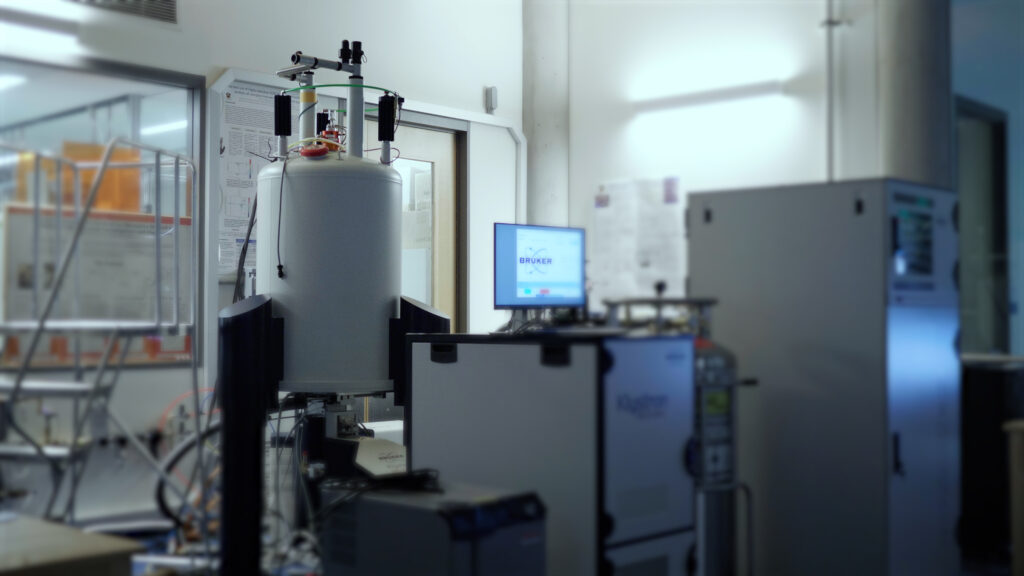
NMR Facility
The Department of Chemistry houses a world-class Nuclear Magnetic Resonance (NMR) Facility with outstanding instrumental power and experimental capabilities. Occupying 2,606 square feet, the Facility’s infrastructure is made of special aluminum and non-magnetizable stainless steel.
The NMR Facility is critical to many wide-ranging research programs and supports almost 300 users from Chemistry and other departments at Princeton University, as well as a number of outside companies that are members of Chemistry’s Industrial Associates Program.
We offer seven state-of-the-art liquid-state NMR spectrometers uniquely configured to meet the needs of our researchers with a high level of automation, which allows high-throughput, 24/7 operation. Instruments include a 300 MHz, a 400 MHz, four 500 MHz, and an 800 MHz spectrometer, with two or three RF channels. Most use a NEO console and are equipped with a modern, 60-seat SampleCase autosampler. Between them, the spectrometers allow users to detect many nuclei, such as 1H, 13C, 15N, 31P, 29Si, 11B, 7Li, 2H, 109Ag, 14N, and many more, over a wide range of temperature control.
Three 500 MHz spectrometers are equipped with a He-cooled cryoprobe of different configuration each; a TCI (A1), a tunable multinuclear device (A2), and a special 13C-detection optimized C-H DUAL probe (A3). A high-power (up to 1,700 Gcm) multinuclear diffusion probe is also available for the A2 instrument. The 800 MHz machine is equipped with a special 3 mm TCI cryoprobe; a custom-made 5 mm QCI-F probe is also available on demand. The 400 MHz instrument offers a nitrogen-cooled Prodigy BBF cryoprobe and a SampleXpress autosampler. A 500 MHz machine has an Avance III HD console and a BBFO RT probe as well as two HR-MAS probes (H/C/15N and H/C/14N, respectively).
All spectrometers are open for walk-up use, enjoying the benefits of full automation. Help and assistance is always available from Ken Conover (NMR Specialist) and István Pelczer (Lecturer; Director, NMR Facility) as needed for setting up experiments, data processing and analysis, and evaluation of the NMR data. For sophisticated multi-dimensional NMR data processing and analysis and modeling we advise users to use NMRPipe and X-Plor-NIH from the wide selection of available powerful software tools.
The NMR Facility at the Department of Chemistry also houses and maintains a top of the line solid-state NMR instrument equipped with a klystron-based DNP accessory, which is a latest generation Bruker 400 MHz WB system. It has two probes for conventional ssNMR applications (using 3.2 mm and 1.3 mm rotors, respectively) and NEO console. One probe (3.2 mm) is a two-channel tunable multinuclear probe, the 1.3 mm probe is triple resonance with several nuclei available using inserts – the collection of nuclei is expandable. The maximum speed for the 3.2 mm rotor is 25 kHz, the 1.3 mm rotor was tested at 60+ kHz, which allows proton-detected sophisticated experiments. Each probe has a wide range of temperature control.
In addition, the instrument has a DNP (Dynamic Nuclear Polarization) accessory with klystron-based MW source and two probes also (with 3,2 mm and 1.3 mm rotors, respectively). The DNP enhancement may exceed a 100+fold sensitivity increase, allowing drastic shortening of the experiment time or accessing low sensitivity nuclei or very small quantity samples. The default operation is at 100K using nitrogen cooling, supported by the latest, third generation temperature controller unit. The probes are multinuclear with inserts and at RT they can be used as conventional ssNMR probes, as well.
All instruments are controlled by the latest TopSpin software and can run a large variety of 1D and 2D/nD correlation experiments, water suppression is routine. The liquid state instruments are equipped with ICON automation interface.
The default processing software MestreNova or the processing-only version of TopSpin, NMRPipe recommended for nD experiments.
See the embedded video on this page for a quick introduction to the ssNMR instrument.
Once an experiment is complete, the data can be downloaded to a remote personal computer through a secure connection, or from the Facility’s own computer cluster. For offline data processing, we provide campus-wide licenses for MNova (MestreLab)/Modgraph.
Our spectrometers require liquid helium to cool the magnets and we recover 60 to 80 percent of the helium in a closed system with the help of the Physics Department as a cost-saving and environmentally friendly measure. The facility receives financial support for new instrumentation from Princeton University and the Department of Chemistry, and maintains its operation from user fees based on experiment time.
